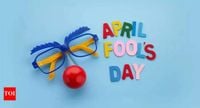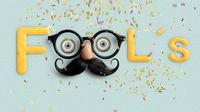The day is here! April Fools’ Day, when pranksters have a field day, while those at the receiving end of those pranks are left quite speechless! Celebrated worldwide on April 1, All Fools’ Day is a day of pulling jokes, pranks, and hoaxes. As the internet memelords instruct, on this day, you might even profess your feelings to your crushes, and if their response is less heartfelt than you’d have expected, you could just end the whole episode of agony by saying two words - April Fools!
Although April Fools’ Day has become a part of popular culture of late, the origin of the tradition dates way back. What is April Fools’ Day? April Fools' Day is an annual custom on April 1st consisting of practical jokes, pranks, and hoaxes. Pranksters often expose their actions by shouting "April Fools!" at the recipients. The All Fools’ Day has had us acting foolish (for the pranksters among us) or scratching our heads (for the prankees among us) every year for centuries now. Mass media can be involved with these pranks, which may be revealed as such the following day.
The custom of setting aside a day for playing harmless pranks upon one's neighbor has been relatively common in the world historically. But how did this dedicated day for tomfoolery come about? The origin story: Although there are multiple theories on the origin of the April Fools’ Day, the exact one has not been zeroed down yet. However, here are some potential ones.
A disputed association between April 1st and foolishness is in Geoffrey Chaucer's The Canterbury Tales (1392). In the "Nun's Priest's Tale", a vain cock, Chauntecleer, is tricked by a fox "Since March began, full thirty days and two," i.e. the 32nd day from March 1st, which is April 1st. However, it is not clear that Chaucer was referencing April 1st since the text of the "Nun's Priest's Tale" also states that the story takes place on the day when the sun is "in the sign of Taurus had y-rune Twenty degrees and one," which would not be April 1st. Modern scholars believe that there is a copying error in the extant manuscripts and that Chaucer actually wrote, "Syn March was gon." If so, the passage would have originally meant 32 days after March, i.e., May 2nd.
Another theory comes from 1508, when French poet Eloy d'Amerval referred to a poisson d'avril (April fool, literally "April's fish"), possibly the first reference to the celebration in France. As per some historians, April Fools' originated because, in the Middle Ages, New Year's Day was celebrated on March 25 in most European towns, with a holiday that in some areas of France, specifically, ended on April 1, and those who celebrated New Year's Day on January 1 made fun of those who celebrated on other dates by the invention of April Fools' Day.
The use of January 1 as New Year's Day became common in France only in the mid-16th century, and that date was not adopted officially until 1564, by the Edict of Roussillon, as called for during the Council of Trent in 1563. However, there are issues with this theory because there is an unambiguous reference to April Fools' Day in a 1561 poem by Flemish poet Eduard de Dene of a nobleman who sent his servant on foolish errands on April 1, predating the change. April Fools' Day was also an established tradition in Great Britain before January 1 was established as the start of the calendar year. In 1686, John Aubrey referred to the celebration as "Fooles holy day"; the first British reference. On April 1, 1698, several people were tricked into going to the Tower of London to "see the Lions washed".
However, that is not all. Some have expressed the belief that the origins of April Fools' Day may go back to the Genesis flood narrative, although no biblical scholar or historian is known to have mentioned a link. Now, the Genesis flood narrative (chapters 6–9 of the Book of Genesis) is a Hebrew flood myth that tells of God's decision to return the universe to its pre-creation state of watery chaos and remake it through the microcosm of Noah's ark. Writer William Ralston Balch wrote in The Complete Compendium of Universal Knowledge of 1895: "Humorous Jewish Origin of the Custom of Making Fools on the First of April.—This is said to have begun from the mistake of Noah in sending the Dove out of the Ark before the water had abated, on the first day of the month among the Hebrews, which answers to the 1st of April; and to perpetuate the memory of this deliverance it was thought proper, who ever forgot so remarkable a circumstance, to punish them by sending them upon some sleeveless errand similar to that ineffectual message upon which the bird was sent by the Patriarch." Balch added, "The custom appears to be of great antiquity, and to have been derived by the Romans from some of the Eastern nations."
On April Fools' Day, a global tradition involves playing harmless pranks and practical jokes on friends, family, and even strangers, with the goal of eliciting laughter and lighthearted fun. Here's a more detailed look: The most common tradition is to play pranks, which can range from simple jokes to more elaborate schemes. Examples of pranks include spreading false information or creating fake news stories, placing something unexpected in a location, such as Saran wrap over a toilet seat, covering vegetables with chocolate and giving them to children, or making a sponge cake out of a sponge. Making prank calls to friends or strangers is also common.
The tradition is celebrated worldwide, with variations in the types of pranks and jokes that are played, with the main goal being to have fun and to bring a lighthearted atmosphere to the day. The team at Slingo explains that there isn’t just one theory as to how the annual day came about, saying: “There’s not one confirmed theory for the origin of the day, however, one popular theory originates from the theory that April Fools’ Day is linked to the vernal equinox. The unpredictable and changeable weather around this time led to the idea that Mother Nature was fooling people. With the end of winter, some April Fools’ Day history could be linked to the idea that creative energies return as spring starts.”
However, the spring equinox does not occur on April 1st, leading to the question of how we have come to celebrate on this particular day. One theory for the origin of April Fools’ Day is linked to the vernal equinox and the unpredictable weather around that time. In 1582, France switched from the Julian calendar to the Gregorian calendar, and those who continued to celebrate the New Year around April 1st were called “April fools” for failing to recognize the change of the calendars. Another popular theory among historians comes from ancient Rome. Hilaria, which is Latin for joyful, were festivals celebrated towards the end of March by followers of the cult of Cybele and entailed members of the cult dressing up in disguises and mocking and pulling jokes towards citizens. The festival was said to be inspired by the Egyptian legends of Osiris, Isis, and Seth and is now said to have potentially inspired April Fools’ Day as we know it today.
Despite its uncertain origins, April Fools’ Day continues to thrive. Some historians believe that cultures worldwide have long associated the arrival of spring with playful mischief and symbolic role reversals. The Museum of Hoaxes even suggests that such traditions date back centuries as part of seasonal festivals. The first day of April remains a time for laughter, surprise, and a little bit of good-natured deception — whether it’s a simple joke among friends or a corporate prank that goes viral. So, if you find yourself the target of a prank this year, just remember to take it in stride. After all, it’s tradition!






